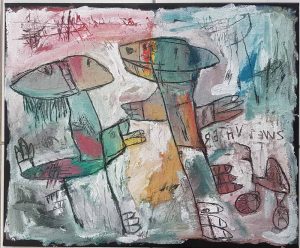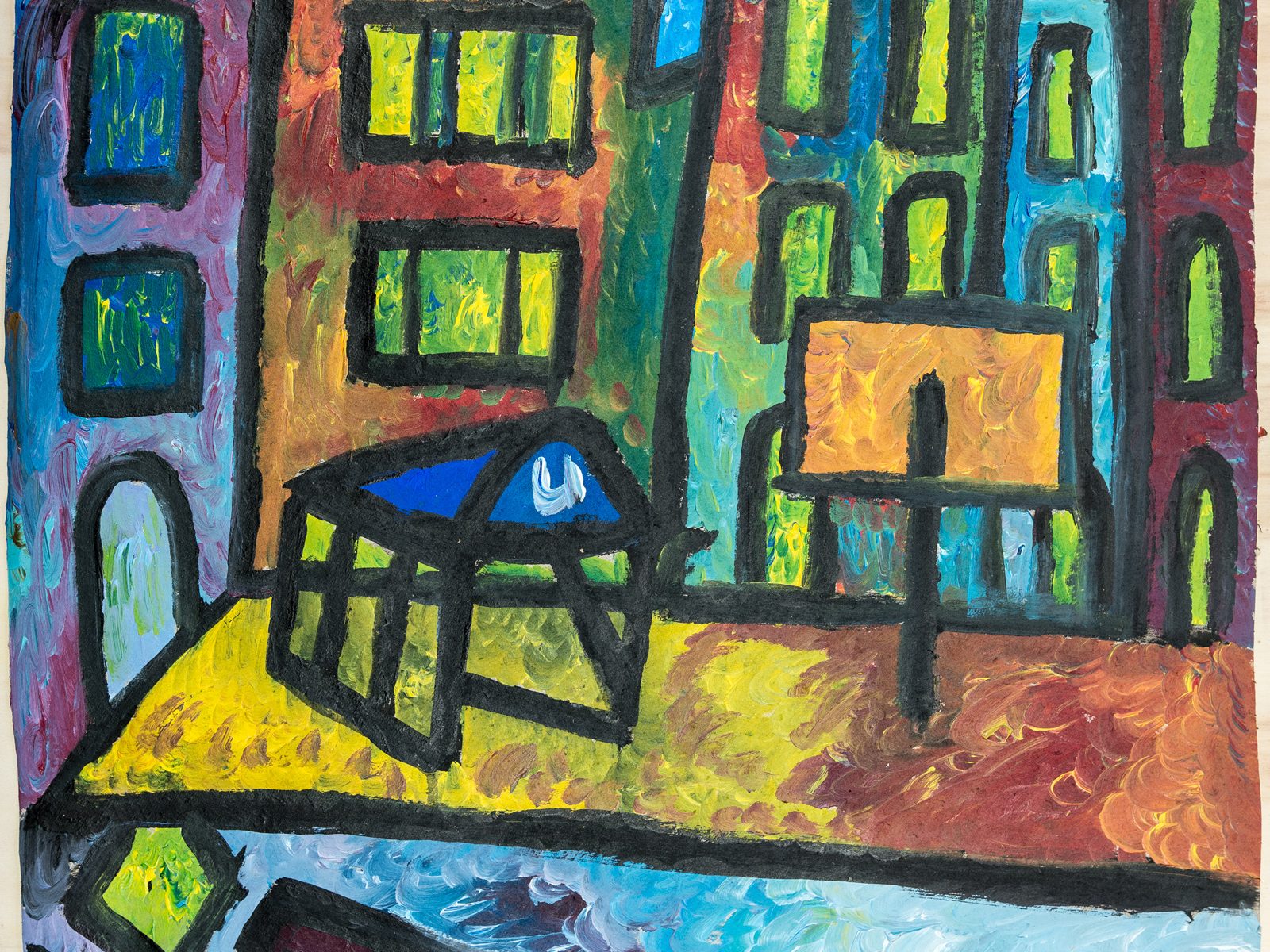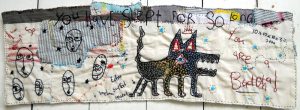Peter Pankow
Uwe Paulsen & Emiehl Päffel





Peter Padubrin-Thomys
The self-taught artist (b. 1968 Halle/Saale GER) works mostly with acrylics on canvas or paper at the moment after having focused for years on collages, linoleum- and woodcuts. His pasty paintings often depict humans or figures resembling angels. With a special pen and great graphic talent he shoves aside the soft paint. The dark priming color appears and gives contours to his characters. Their heads, hands or limbs fill up the pictorial space disproportionally, which bestows them a unique energy and spontaneity. When the artist works with a contrast-rich and wild color palette his figures are reminiscent of Basquiat or they resemble – when he uses more delicate white, gray and pastel tones – Paul Klee’s angel drawings.
Peter Padubrin-Thomys deliberately chooses an outsider art or art brut approach for his acrylic paintings: they appear sketch-like and bizarre, raw and color-intensive. His figures emanate an aura with a magic appeal. Placed alone or in groups they develop a fascinating, dreamy and mysterious effect. They float through the image and appear to relate to each other meaningfully and don’t seem to follow any common rules. Oftentimes the figures reach their oversized hands or limbs towards the other or communicate with another like in the untitled motif from the series “In Pantoffeln durch die Träume” (“Through the Dreams in Slippers”). In some kind of game strong forms of expression occur. Other titles (like e.g. “Zwei Väter” “Two Fathers” or “Der Hüter der Herde” “The Guardian of the Herd”), which are sometimes written into the painting by the artist, give further clues to the content of the depicted figures or complement them imaginatively.
A naïve prevailing mood resonates through the pictures. At a closer look however it becomes obvious that Peter Padubrin-Thomys develops a special impetus – between mind and matter, inside and outside worlds, lightness and depth.
Michael Rasmussen



Andrea Rausch
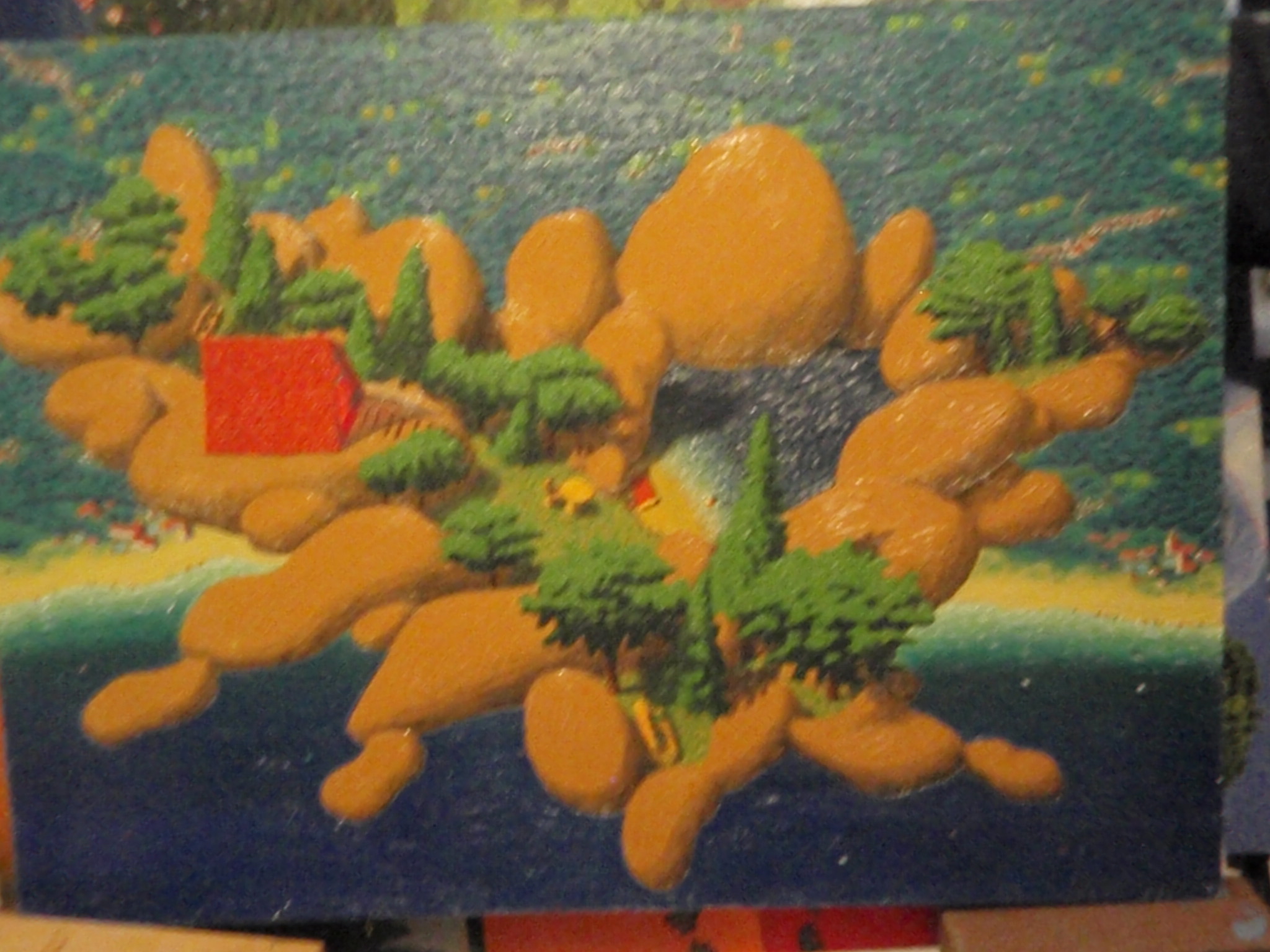
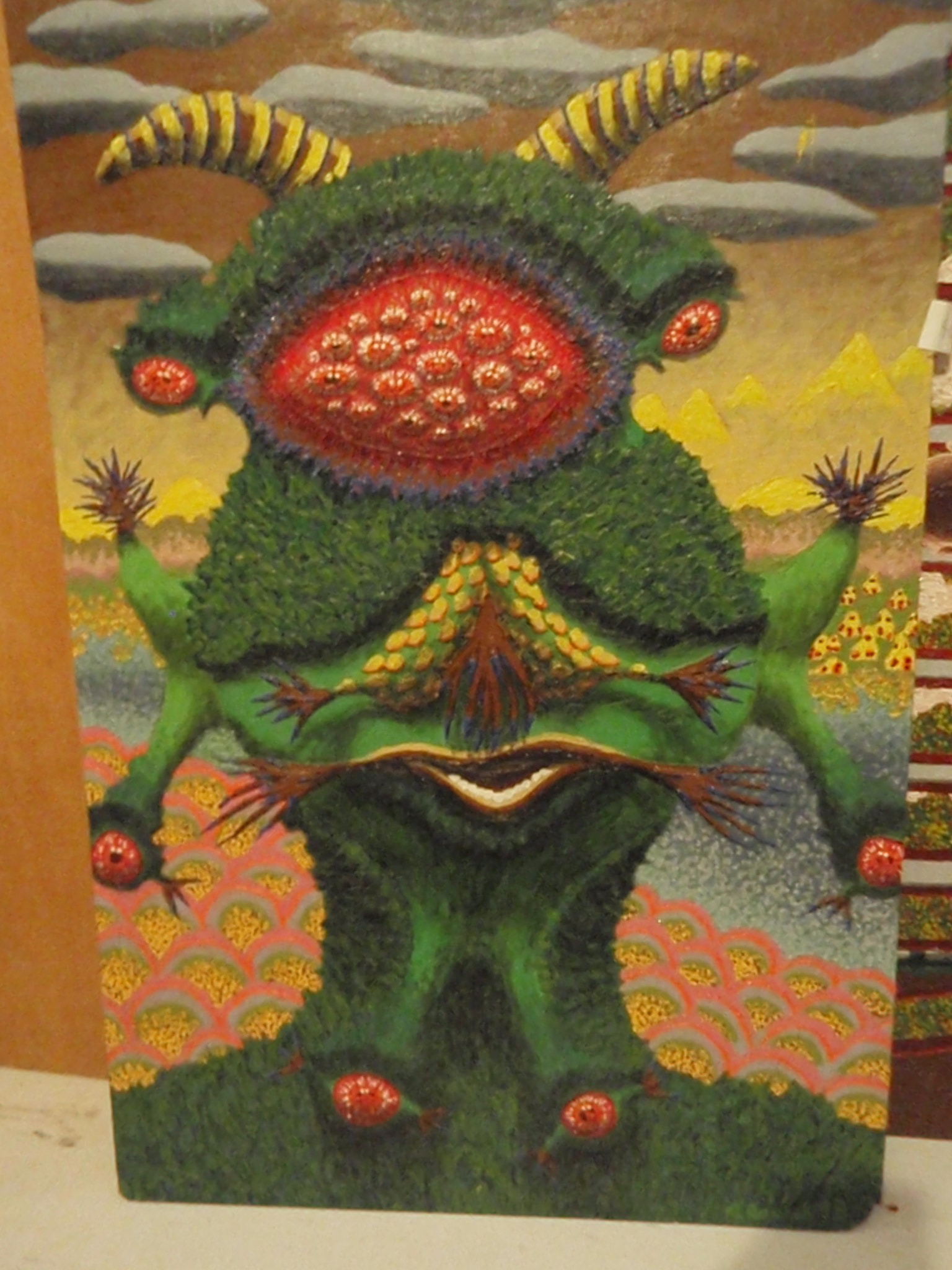

Oliver Rincke
His vibrant compositions use wool and yarn on cardboard for a captivatingly colorful effect. With a meticulously planned work process, Oliver Rincke punches holes into the cardboard before he threads through thick layers of wool, string by string. The result is a unique expression of textile art, crafted with a pictorial world that brings to mind South American art and pop culture. In his wool compositions he finds inspiration in motifs found in magazines, books and the internet: Mexican masks, the belts of wrestlers, vehicles, cartoon characters and beyond. Different elements get combined and are outlined on the cardboard before he “paints in” the threads. Typically, Oliver Rincke works on 2-3 pieces simultaneously. The artist has been constantly developing this compelling approach since participating in a pivotal textile workshop in 2013. The intense burst of colors and the discernible contour of his images instantly catch the eye. Although powerful, direct and excessive, they never come across as aggressive or shrill, with select pastel tones creating a counterbalance. The impulsive, tense and unexpected formations unique to his output don’t allow for any decorative sweetness. The works of Oliver Rincke develop an immediate and very distinct appeal that audiences have already noted on display at POSITIONS Art Fair Berlin and in WELTKUNST magazine. An unusual success for a newcomer, which we are now pleased to present in his first solo show at our gallery. Since 2010, Oliver Rincke (b. 1978, Berlin) has been a member of Thikwa, a studio for theater and art, where he has been working successfully as both a stage actor and a visual artist.
Horst Schiele
Press Release for exhibition (04.03.– 15.04.2021)
Galerie ART CRU Berlin shows pictures by Horst Schiele, who was born in Berlin in 1948. It is the first solo exhibition of the artist.
A combination of circles, rectangles and triangles is the underlying basis of each of the artist’s paintings. The associatively set forms are colored with a broad palette in oil pastels, a medium that allows the artist the greatest possible autonomy in his work. Schiele’s forms are often superimposed by one or more additional layers. If one wanders along these surface lines while viewing the drawings, one senses a concentrated force that lends the paintings a special tension and extraordinary compositional dynamism. Sometimes Schiele places the lines close together, usually black or white in contrast to the luminous formations in the background, so that a structure seems to take over the image. Sometimes he chooses airy, bubble-like circles to overlay his color field foundation, or he sets selective accents with shorter strokes. The particular contrasting relationship of these two layers, combined with a richness of variation in the volume of paint application that can differ greatly within and between paintings, offers viewers a fascinating resonance.
After both of his parents died in 1979, Horst Schiele, then 31 years old, moved to Albert Schweitzer Stiftung Wohnen & Betreuen. Until retirement age in 2013, he worked in the Nordberliner Werkstätten (NBW). Since 2014, he has been working on his drawings in the workshop of Albert Schweitzer Stiftung, and has already exhibited them several times in Berlin.
Henry Schönhardt



Jan Sander



Reuven Shezen

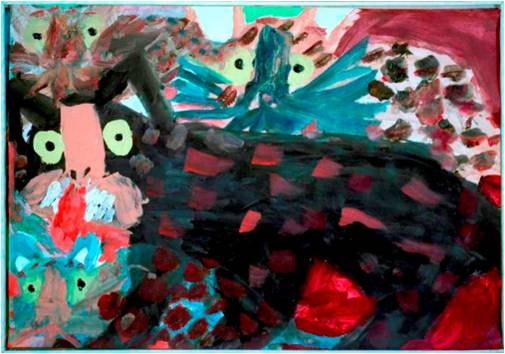
Anthony Stevens
Using delicate embroidery on scrap fabrics and other materials, the artist creates raw and playful images. As a child, Anthony Stevens was already surrounded by textiles. Years later, he decided to use a needle and thread as his form of creative expression. His work is made distinct by figurative and comic style portrayals that are embroidered on his chosen fabric and partly sewn together with many layers, out of many different pieces of fabric. His visual perceptions are playful and full of subtext that can be deciphered by the written comments that compliment the figures. The artist, who has studied Nichiren Buddhism, explains that he sees the images in his mind’s eye while chanting the mantra, “Nam Myoho Renge Kyo.” Roughly translated, the meaning is: “I devote myself to the supreme law of the universe.” During his embroidery work process, the motives develop several levels of meaning. They convey worldly wisdoms or formulated criticism, e.g. consumer behavior in “Black Friday.” In the visual world of Anthony Stevens one can find the amusing, the wondering, and the threatening, as in the recurring motives of a dog, a crowned bird, of penises or combat boots and hand grenades in “Brute Force.” As work material the artist quite intentionally chooses scraps of fabric or stripes and sees himself in the position to find potential in what may seem useless or beyond repair. With this decision, the autodidact sees a very important parallel to his own partly traumatic life and experiences, which he realizes in his works, and describes as “dancing with (his) inner dynamics” – always in search of a constructive rhythm. Anthony Stevens’ works have been shown in numerous group and solo exhibitions in et al. Frankfurt, Brighton and London.
Julian Stręk
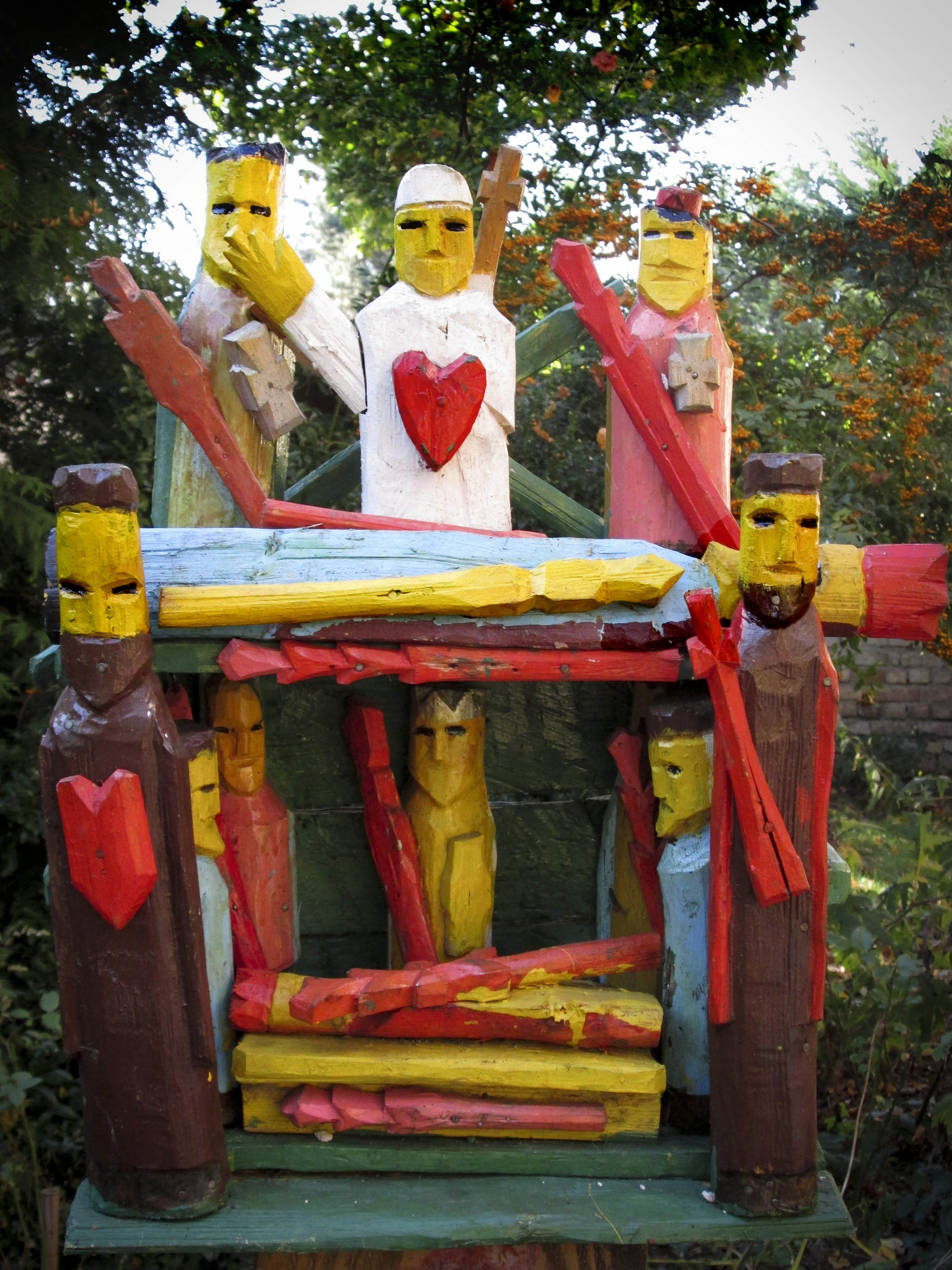


Stefan Stockfleth

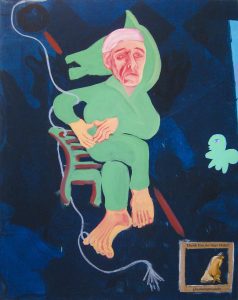

Thi Thu

 o.
o.

Alexander Voitsehovsky



Abram Wilhelm



Abram Wilhelm was born 1944 in Amsterdam, grew up in the Netherlands and lived through several personal crises. His childhood was defined by hunger, hard physical work and the experience of sexual abuse. With the age of 21 he arrived in Germany and started a family. His wife committed suicide in 1981, followed by his son, who took his life 16 years later.
In his art Abram Wilhelm found a crisis response. His sorrows and the extreme experiences are reflecting in the intense works created by this outsider artist. He utilizes different media and a large variety of materials, creates paintings, drawings, collages and sculptures for which he sometimes uses found objects, for example parts of a wooden bed or cigar boxes. His creations, which the artist usually draws completely naked, remind of Hieronymus Bosch. Weightless figures, like the “Insektenhexe“ (insect witch) or „Krakenfrau“ (kraken woman) are hovering through color spaces in which you can find religious or mythical references at times. His works show stomata, body fluids, excrements. As a viewer you sense instinctively that Wilhem is not interested in any sort of affected provocation. Thematically he references “on sexuality, but also on anger”, but never to shock or create a sensation of disgust. In his wildly glowing color palette he creates works primarily for himself, fills every corner of his house with them. They are an invitation to feel an artist’s reception who managed to transform his great experienced sorrow into a highly expressive oeuvre that knows of no taboos or boarders. After his turbulent live Abram Wilhelm trusts his inspirational slogan “Great expectations are waiting for those who follow their soul.”
You can find further information about Abram Wilhelm: www.artbram.de
Melanie Woste
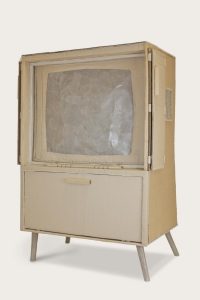

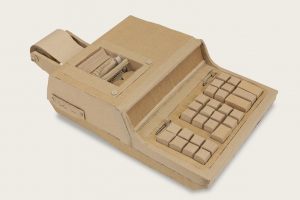
Oskar Zaumseil














